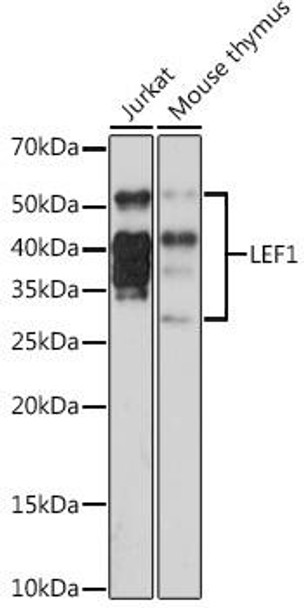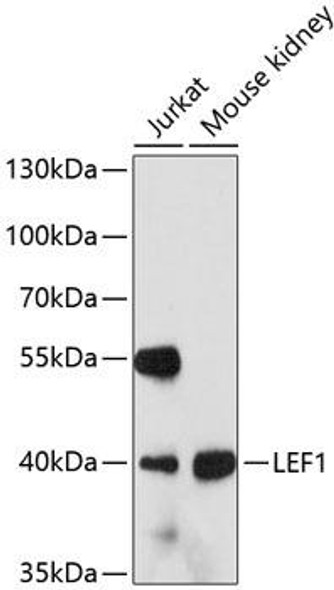Anti-LEF1 Antibody (CAB4473)
- SKU:
- CAB4473
- Product type:
- Antibody
- Antibody Type:
- Monoclonal Antibody
- Reactivity:
- Human
- Mouse
- Host Species:
- Rabbit
- Isotype:
- IgG
- Synonyms:
- LEF-1
- TCF10
- TCF1ALPHA
- TCF7L3
Description
| Product Name: | LEF1 Rabbit mAb |
| Product Code: | CAB4473 |
| Size: | 20uL, 50uL, 100uL |
| Synonyms: | LEF-1, TCF10, TCF1ALPHA, TCF7L3 |
| Applications: | WB |
| Reactivity: | Human, Mouse |
| Host Species: | Rabbit |
| Immunogen: | A synthesized peptide derived from human LEF1 |
| Applications: | WB |
| Recommended Dilutions: | WB 1:500 - 1:2000 |
| Reactivity: | Human, Mouse |
| Positive Samples: | Jurkat, Mouse thymus |
| Immunogen: | A synthesized peptide derived from human LEF1 |
| Purification Method: | Affinity purification |
| Storage: | Store at -20°C. Avoid freeze / thaw cycles. Buffer: PBS with 0.02% sodium azide, 0.05% BSA, 50% glycerol, pH7.3. |
| Isotype: | IgG |
| Sequence: | Email for sequence |
| Gene ID: | 51176 |
| Uniprot: | Q9UJU2 |
| Calculated MW: | 44kDa |
| Observed MW: | 30-50KDa |
| UniProt Protein Function: | LEF-1: a transcription factor of the TCF/LEF family. Participates in the Wnt signaling pathway and regulates T-cell receptor alpha-C enhancer function. Activates transcription of target genes in the presence of CTNNB1 and EP300. TLE1, TLE2, TLE3 and TLE4 repress transactivation mediated by LEF1 and CTNNB1. Binds DNA in a sequence-specific manner. PIAG antagonizes both Wnt-dependent and Wnt-independent activation by LEF1. Deletions in LEF1 have been observed in a subset of pre-B-cell acute lymphoblastic leukemia (B-ALL) cases. Four human isoforms produced by alternative promoter usage and alternative splicing have been described. Isoform 3 lacks the CTNNB1 interaction domain and may be an antagonist for Wnt signaling. |
| UniProt Protein Details: | Protein type:DNA-binding; Transcription factor Chromosomal Location of Human Ortholog: 4q23-q25 Cellular Component: cytoplasm; nucleoplasm; nucleus; transcription factor complex Molecular Function:beta-catenin binding; caspase inhibitor activity; DNA bending activity; DNA binding; estrogen receptor activity; estrogen receptor binding; gamma-catenin binding; histone binding; histone deacetylase binding; protein binding; RNA polymerase II transcription factor activity, enhancer binding; sequence-specific DNA binding; transcription factor activity Biological Process: alpha-beta T cell differentiation; B cell proliferation; BMP signaling pathway; dentate gyrus development; embryonic limb morphogenesis; epithelial to mesenchymal transition; eye pigmentation; forebrain neuroblast division; forebrain neuron differentiation; formation of radial glial scaffolds; hypothalamus development; mammary gland development; muscle fiber development; negative regulation of apoptosis; negative regulation of caspase activity; negative regulation of DNA binding; negative regulation of interleukin-13 production; negative regulation of interleukin-4 production; negative regulation of interleukin-5 production; negative regulation of transcription, DNA-dependent; neural crest cell migration; neutrophil differentiation; osteoblast differentiation; palate development; paraxial mesoderm formation; patterning of blood vessels; positive regulation of cell growth; positive regulation of cell migration; positive regulation of cell proliferation; positive regulation of granulocyte differentiation; positive regulation of transcription from RNA polymerase II promoter; positive regulation of transcription, DNA-dependent; radial glial cell differentiation in the forebrain; regulation of striated muscle development; somitogenesis; sprouting angiogenesis; T-helper 1 cell differentiation; transcription from RNA polymerase II promoter; Wnt receptor signaling pathway; Wnt receptor signaling pathway through beta-catenin; Wnt receptor signaling pathway, calcium modulating pathway |
| NCBI Summary: | This gene encodes a transcription factor belonging to a family of proteins that share homology with the high mobility group protein-1. The protein encoded by this gene can bind to a functionally important site in the T-cell receptor-alpha enhancer, thereby conferring maximal enhancer activity. This transcription factor is involved in the Wnt signaling pathway, and it may function in hair cell differentiation and follicle morphogenesis. Mutations in this gene have been found in somatic sebaceous tumors. This gene has also been linked to other cancers, including androgen-independent prostate cancer. Alternative splicing results in multiple transcript variants. [provided by RefSeq, Oct 2009] |
| UniProt Code: | Q9UJU2 |
| NCBI GenInfo Identifier: | 8928194 |
| NCBI Gene ID: | 51176 |
| NCBI Accession: | Q9UJU2.1 |
| UniProt Secondary Accession: | Q9UJU2,Q3ZCU4, Q9HAZ0, B4DG38, B7Z8E2, E9PDK3, |
| UniProt Related Accession: | Q9UJU2 |
| Molecular Weight: | 34,103 Da |
| NCBI Full Name: | Lymphoid enhancer-binding factor 1 |
| NCBI Synonym Full Names: | lymphoid enhancer binding factor 1 |
| NCBI Official Symbol: | LEF1 |
| NCBI Official Synonym Symbols: | LEF-1; TCF10; TCF7L3; TCF1ALPHA |
| NCBI Protein Information: | lymphoid enhancer-binding factor 1 |
| UniProt Protein Name: | Lymphoid enhancer-binding factor 1 |
| UniProt Synonym Protein Names: | T cell-specific transcription factor 1-alpha; TCF1-alpha |
| Protein Family: | Lymphoid enhancer-binding factor |
| UniProt Gene Name: | LEF1 |
| UniProt Entry Name: | LEF1_HUMAN |




